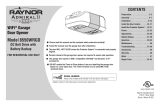
2
Safety Symbol and Signal Word Review
This garage door opener has been designed and tested to offer safe service provided it is installed, operated,
maintained and tested in strict accordance with the instructions and warnings contained in this manual.
Mechanical
Electrical
When you see these Safety Symbols and Signal Words on
the following pages, they will alert you to the possibility of
serious injury or death if you do not comply with the
warnings that accompany them. The hazard may come
from something mechanical or from electric shock. Read
the warnings carefully.
When you see this Signal Word on the following pages, it
will alert you to the possibility of damage to your garage
door and/or the garage door opener if you do not comply
with the cautionary statements that accompany it. Read
them carefully.
WARNING: This product can expose you to chemicals including lead, which are known to the State of
California to cause cancer or birth defects or other reproductive harm. For more information go to
www.P65Warnings.ca.gov
Unattended Operation
The Timer-to-Close (TTC) feature, the MyQ
®
Smartphone Control app, and MyQ
®
Garage Door and Gate Monitor
are examples of unattended close and are to be used ONLY with sectional doors. Any device or feature that allows the
door to close without being in the line of sight of the door is considered unattended close. The Timer-to-Close (TTC)
feature, the MyQ
®
Smartphone Control, and any other MyQ
®
devices are to be used ONLY with sectional doors.
Check the Door
To prevent possible SERIOUSINJURYor DEATH:
l ALWAYS call a trained door systems technician if garage door binds, sticks, or is out of balance. An
unbalanced garage door may NOT reverse when required.
l NEVER try to loosen, move or adjust garage door, door springs, cables, pulleys, brackets or their hardware,
ALLof which are under EXTREME tension.
l Disable ALLlocks and remove ALLropes connected to garage door BEFORE installation and operating
garage door opener to avoid entanglement.
l DO NOT install on a one-piece door if using devices or features providing unattended close. Unattended
devices and features are to be used ONLY with sectional doors.
To prevent damage to garage door and opener:
l ALWAYS disable locks BEFORE installing and operating the opener.
l ONLY operate garage door opener at 120V, 60Hz to avoid malfunction and damage.
Before you begin:
1. Disable locks and remove any ropes connected to the garage door.
2. Lift the door halfway up. Release the door. If balanced, it should stay in place,
supported entirely by its springs.
3. Raise and lower the door to check for binding or sticking. If your door binds,
sticks, or is out of balance, call a trained door systems technician.
4. Check the seal on the bottom of the door. Any gap between the floor and the
bottom of the door must not exceed 1/4 inch (6 mm). Otherwise, the safety
reversal system may not work properly.
5. The opener should be installed above the center of the door. If there is a torsion
spring or center bearing plate in the way of the header bracket, it may be
installed within 4feet (1.2 m) to the left or right of the door center. See page 12.
Torsion
Spring
Extension
Spring
OR
Preparation























